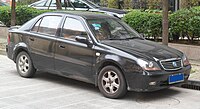
The Fiat Palio is a supermini car released by the Italian manufacturer Fiat in April 1996. It was produced until 2020.
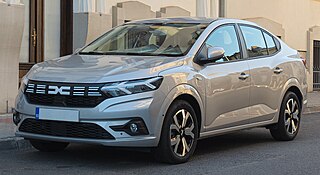
The Dacia Logan is a family of automobiles produced and marketed jointly by the French manufacturer Renault and its Romanian subsidiary Dacia since mid-2004, and was the successor to the Dacia 1310 and Dacia Solenza. It has been produced as a sedan, station wagon, and as a pick-up. It has been manufactured at Dacia's automobile plant in Mioveni, Romania, and at Renault plants in Morocco, Brazil, Argentina, Turkey, Russia, Colombia, Iran and India. The pick-up has also been produced at Nissan's plant in Rosslyn, South Africa.

The Nissan Tiida is a compact car produced by the Japanese manufacturer Nissan from 2004 to 2023 through three generations. Depending on the market, the Tiida was also marketed as a subcompact car, particularly in the Americas for the first-generation model as the Nissan Versa. The first-generation model (C11) was produced up to 2018 in some markets, and was offered as a four-door sedan and a five-door hatchback.

The Kia Rio is a subcompact car manufactured by Kia from 1999 to 2023. Body styles have included a three and five-door hatchback and four-door sedan, equipped with inline-four gasoline and diesel engines, and front-wheel drive.

The Hyundai Accent, or Hyundai Verna is a subcompact car produced by Hyundai. In Australia, the first generation models carried over the Hyundai Excel name used by the Accent's predecessor. The Accent was replaced in 2000 by the Hyundai Verna in South Korea, although most international markets, including the US, retained the "Accent" name. The "Accent" name is an abbreviation of Advanced Compact Car of Epoch-making New Technology.

The Kia Carens is a compact car (C-segment) manufactured by Kia since 1999, spanning over four generations, and was marketed worldwide under various nameplates, prominently as the Kia Rondo. The initial three generations had a MPV body style and were marketed worldwide, with presence in its home country South Korea, in Europe, and North America since the second-generation. The fourth-generation model took a different approach in terms of design and targeted markets, as it was developed as a "strategic model" for the Indian market. It also adopts a crossover-inspired exterior design.

The Kia Picanto is a city car that has been produced by the South Korean car manufacturer, Kia, since 2003. Other names of the car include Kia Morning in South Korea, Hong Kong, Taiwan and Chile, Kia EuroStar in Taiwan, Kia New Morning in Vietnam and the Naza Suria or Naza Picanto in Malaysia. The Picanto is primarily manufactured at the Donghee joint-venture plant in Seosan, South Korea, though some countries locally assemble complete knock-down versions of the car.

The MG3 is a small car produced by the Chinese automotive company SAIC. The first generation, marketed as the MG3 SW, is based on the British made Rover Streetwise, which itself was based on the Rover 25, while the second generation, introduced in 2011 is marketed simply as the MG3.
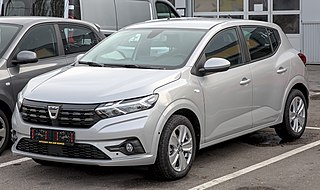
The Dacia Sandero is a subcompact car/supermini (B-segment) car produced and marketed jointly by the French manufacturer Renault and its Romanian subsidiary Dacia since 2007, currently at its third generation. It has been also marketed as the Renault Sandero in certain markets, such as Russia, Latin America, Iran, Egypt, and Sub-Saharan Africa.

The Volkswagen Polo Mk5 is the fifth generation of the Polo, a supermini-class car manufactured by Volkswagen since 2009. The vehicle unveiled at the 2009 Geneva Motor Show in March 2009, while the three-door version was unveiled at the 2009 Frankfurt Motor Show in September 2009. A four-door long-wheelbase sedan version has been produced and sold outside Europe in several emerging markets since 2010 either as the Volkswagen Vento or the Volkswagen Polo sedan. A short-wheelbase sedan version was sold in India between 2016 and 2020 as the Volkswagen Ameo.

The BYD F0, formerly known as BYD F1, is a city car produced by the Chinese manufacturer BYD. It was introduced in July 2008 and was produced until 2015. Although petrol versions were discontinued, a subsequent electric version, branded under the new "e series" was launched in 2019 as the BYD e1.

The Lifan 320 is a supermini made by Lifan Group. Sales began in 2009, and a facelift was conducted in 2013. A more upmarket variant called the Lifan 330 was also available from 2013. The Lifan 320 was also produced and sold in foreign markets and was sold in Russia as the Lifan Smily.

The Latin New Car Assessment Programme is an automobile safety assessment programme for Latin America and the Caribbean. Founded in 2010, it offers independent information to consumers about the safety levels of new cars in the market. Latin NCAP tests are based in international renowned methodologies, with vehicles awarded a safety rating between 0 and 5 stars, indicating the protection the cars offer to adult and child occupants. The programme started as a joint initiative and in 2014 it was established as an association under a legal entity framework.
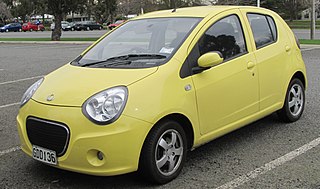
The Geely LC, sold in its home market as the Geely Panda or the Gleagle Panda, is a city car produced by the Chinese manufacturer Geely Auto from November 2008 to 2016. In 2010 the LC scored 45.3 in C-NCAP crash tests, making it China's first locally researched and developed compact car to be awarded a 5-star rating, and it is subsequently the safest Chinese hatchback as of 2011. The LC was able to achieve the above despite a development process that relied more on computer simulations than actual crash tests. In 2017, The Panda was replaced by a facelifted version of the car known as the Geely Yuanjing X1.

The Peugeot 301 is a subcompact (B-segment) sedan produced by the French automaker Peugeot since 2012. It was announced to the public in May 2012, with an official launch that took place at the Paris Motor Show in September. The 301 is built at Peugeot's Vigo plant in Spain, alongside its twin Citroën C-Elysée, and has been manufactured in China since November 2013. It is also assembled as a CKD in other markets such as Kazakhstan and Nigeria.
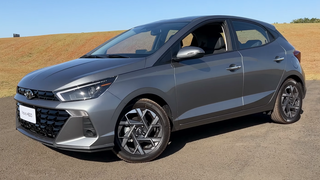
The Hyundai HB20 is a subcompact car produced by South Korean manufacturer Hyundai Motor Company since 2012 in Brazil. It is the first and only Hyundai model strategically developed and produced exclusively for the Brazilian market. Offered with a range of flex-fuel engines, it was not exported to other Latin American countries until 2016, when it began to be sold in Paraguay and Uruguay, and eventually in Mexico and Colombia in 2022.

The Volkswagen Virtus is a subcompact sedan (B-segment) manufactured by the German automaker Volkswagen since 2018. It is based on the Polo Mk6 with an extended wheelbase and the same Volkswagen Group MQB A0 platform, which it also closely shares with the Taigo/Nivus and T-Cross/Taigun.

The Englon SC5-RV is a subcompact hatchback produced by Chinese auto manufacturer Englon. It debuted as a concept at the 2010 Beijing Auto Show. Price ranges from 52.300 yuan to 56.300 yuan.

The Chery Tiggo 3, or originally the Chery Tiggo, is a compact crossover produced by the Chinese manufacturer Chery since 2005. The original Tiggo first debuted at the 2005 Shanghai Motor Show and was called the NCV, meaning New Concept Vehicle. It is the first product of the Chery Tiggo series. The original vehicle was facelifted in September 2010, and received the name change to Tiggo 3 and another facelift in 2014.
GlobalNew Car Assessment Programme is a project of the Towards Zero Foundation, a UK-registered charity. The programme serves as an umbrella organisation encouraging co-operation between the various New Car Assessment Programmes around the world, and supports campaigns to inform consumers about the safety of vehicles in markets that are weakly regulated or do not yet have their own consumer safety programmes.



